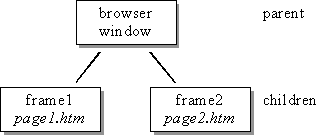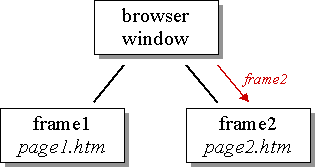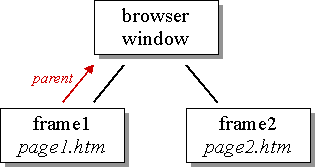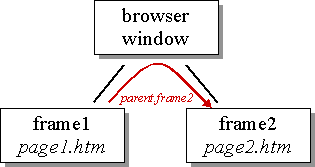
Part 3: Frames
Creating frames
An often asked question is how frames and JavaScript work together. First
I want to explain what frames are and what they can be used for. After this
we will see how we can use JavaScript in combination with frames.
The browser window can be split up into several frames. This means a frame
is a square area inside the browser window. Each frame displays its
own document (most of the time HTML-documents). So you can for example create
two frames. In the first frame you load the homepage of Netscape and in the
second frame you load the homepage of Microsoft.
Although creating frames is a HTML-problem I want to describe the basic
things. For creating frames you need two tags: <frameset> and <frame>.
A HTML-page creating two frames might look like this:
<html> <frameset rows="50%,50%"> <frame src="page1.htm" name="frame1"> <frame src="page2.htm" name="frame2"> </frameset> </html>This will produce two frames. You can see that we use the rows property in the <frameset> tag. This means the two frames lie above each other. The upper frame loads the HTML-page page1.htm and the lower frame displays the document page2.htm. If you push the button you can see what this looks like:
If you want to have columns instead of rows you write cols instead of
rows in the <frameset> tag. The "50%,50%" part specifies how
large the two windows are. You can also write "50%,*" if you do not
want to calculate how large the second frame must be in order to get 100%.
You can specify the size in pixels by omitting the % symbol.
Every frame gets an unique name with the name property in the
<frame> tag. This will help us when accessing the frames through
JavaScript.
You can have several nested <frameset> tags. I've found this example in the documentation provided by Netscape (I just modified it a little bit):
<frameset cols="50%,50%">
<frameset rows="50%,50%">
<frame src="cell.htm">
<frame src="cell.htm">
</frameset>
<frameset rows="33%,33%,33%">
<frame src="cell.htm">
<frame src="cell.htm">
<frame src="cell.htm">
</frameset>
</frameset>
Have a look at this example:
You can set the size of the border through the border property in the <frameset> tag. border=0 means that you do not want to have a border (does not work with Netscape 2.x).
Now we want to have a look at how JavaScript 'sees' the frames in a
browser window. For this we are going to creat two frames as shown
in the first example of this part.
We have seen that JavaScript organizes all elements on a webpage
in a hierarchy. This is the same with frames. The following image
shows the hierarchy of the first example of this part:

At the top of the hierachy is the browser window. This window
is split up into two frames. The window is the parent in this
hierarchy and the two frames are the children. We gave the two
frames the unique names frame1 and frame2. With
the help of these names we can exchange information between the
two frames.
A script might have to solve the following problem: The user
clicks on a link in the first frame - but the page shall be
loaded in the second frame rather than in the first frame. This
can for example be used for menubars (or navigationbars) where
one frame always stays the same and offers several different
links to navigate through a homepage.
We have to look at three cases:
From the window's point of view the two frames are called frame1 and frame2. You can see in the image above that there is a direct connection from the parent window to each frame. So if you have a script in the parent window - this means in the page that creates the frames - and you want to access the frames you can just use the name of the frame. For example you can write:
frame2.document.write("A message from the parent window.");

Sometimes you want to access the parent window from a frame. This is needed for example if you want to remove the frames. Removing the frames just means to load a new page instead of the page which created the frames. This is in our case the page in the parent window. We can access the parent window (or parent frame) from the child frames with parent. In order to load a new document we have to assign a new URL to location.href. As we want to remove the frames we have to use the location-object of the parent window. As every frame can load its own page we have a different location-object for each frame. We can load a new page into the parent window with the command:
parent.location.href= "http://...";

Very often you will be faced with the problem to access one child frame from another child frame. So how can you write something from the first frame to the second frame - this means which command do you have to use in the HTML-page called page1.htm? In our image you can see that there is no direct connection between the two frames. This means we cannot just call frame2 from the frame frame1 as this frame does not know anything about the existence of the second frame. From the parent window's point of view the second frame is called frame2 and the parent window is called parent seen from the first frame. So we have to write the following in order to access the document-object of the second frame:
parent.frame2.document.write("Hi, this is frame1 calling.");

Let's have a look at a navigationbar. We will have several links in one frame. If the user clicks on these links the pages won't show up in the same frame - they are loaded in the second frame.
Here is the example:
First we need a script which creates the frames. This document looks like the first example we had in this part:
frames3.htm
<html> <frameset rows="80%,20%"> <frame src="start.htm" name="main"> <frame src="menu.htm" name="menu"> </frameset> </html>The start.htm page is the entry page which will be displayed in the main frame at the beginning. There are no special requirements for this page.
menu.htm
<html>
<head>
<script language="JavaScript">
<!-- hide
function load(url) {
parent.main.location.href= url;
}
// -->
</script>
</head>
<body>
<a href="javascript:load('first.htm')">first</a>
<a href="second.htm" target="main">second</a>
<a href="third.htm" target="_top">third</a>
</body>
</html>
Here you can see different ways for loading a new page into the
frame main. The first link uses the function load().
Have a look at how this function is called:
<a href="javascript:load('first.htm')">first</a>
You can see that we can let the browser execute JavaScript code instead
of loading another page - we just have to use javascript: in the
href property. You can see that we write 'first.htm'
inside the brackets. This string is passed to the function load().
The function load() is defined through:
function load(url) {
parent.main.location.href= url;
}
There you can see that we write url inside the brackets. This means
that the string 'first1.htm' is stored in the variable url. Inside
the load() function we can now use this variable. We will see further
examples of this important concept of variable passing later on.So which way should you choose? This depends on your script and what you want to do. The target property is very simple. You might use it if you just want to load the page in another frame. The JavaScript solution (i.e. the first link) is normally used if you want to do several things as a reaction to the click on the link. One common problem is to load two pages at once in two different frames. Although you could solve this with the target property using a JavaScript function is more straightforward. Let's assume you have three frames called frame1,frame2 and frame3. The user clicks on a link in frame1. Then you want to load two different pages in the two other frames. You can use this function for example:
function loadtwo() {
parent.frame1.location.href= "first.htm";
parent.frame2.location.href= "second.htm";
}
If you want to keep the function more flexible you can use variable passing here
as well. This looks like this:
function loadtwo(url1, url2) {
parent.frame1.location.href= url1;
parent.frame2.location.href= url2;
}
Then you can call this function with loadtwo("first.htm", "second.htm") or
loadtwo("third.htm", "forth.htm"). Variable passing makes your function
more flexible. You can use it over and over again in different contexts.
©1996,1997 by Stefan Koch
e-mail:skoch@rumms.uni-mannheim.de
http://rummelplatz.uni-mannheim.de/~skoch/
My JavaScript-book